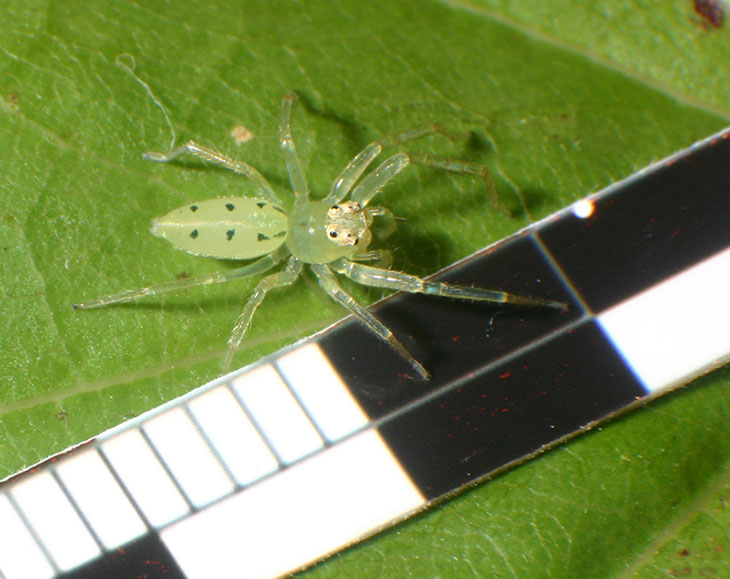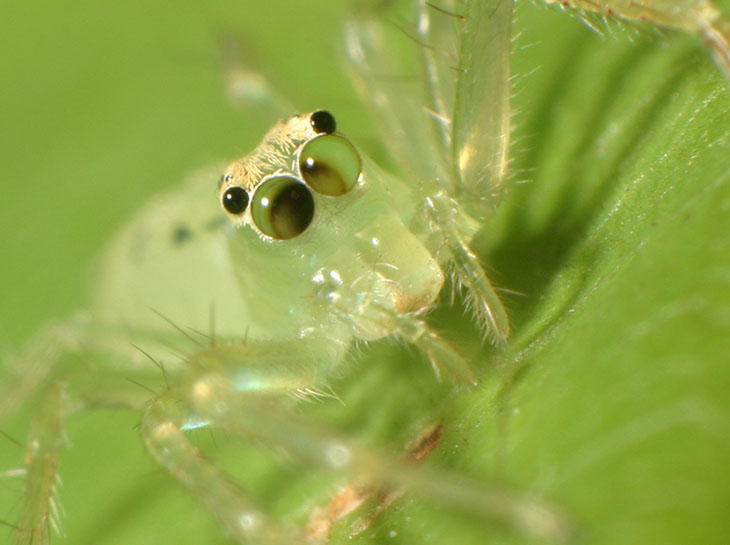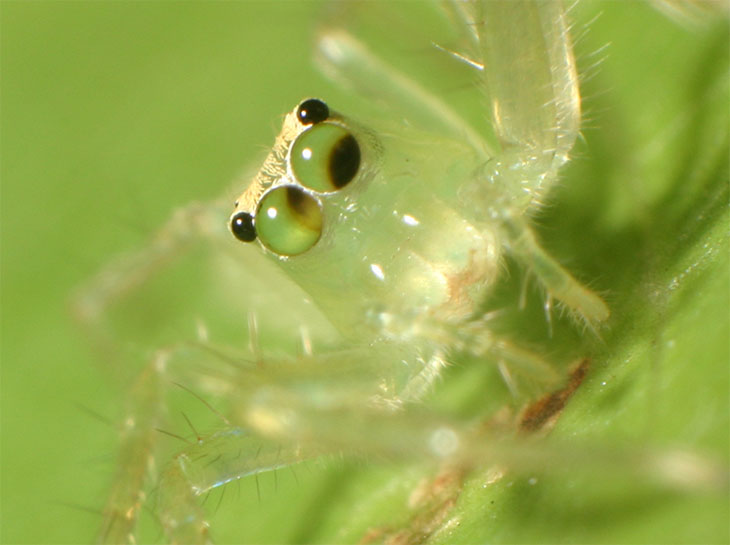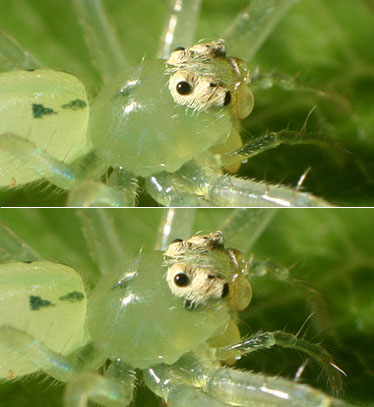
Lyssomanes viridis, known to those of us who do not speak dead languages as the magnolia green jumping spider, is a lovely translucent green spider that wouldn’t hurt a fly um, is harmless to anything larger than a honyebee and is undeserving of any arachnophobic reactions. Until you get close. Really, really close.
Because, while all jumping spiders have the same equipment, on the magnolia green jumper, you can actually see it. In operation. The ‘anterior median’ (big center two) eyes are quite well-developed for an arthropod, allowing jumping spiders to accurately judge the distance to their prey and across the chasms they leap. Since the cornea of the eyes is part of the exoskeleton of the entire spider, shed with everything else during a molt, the moving bits of the eyes are inside. The translucent chitin of the magnolia green jumper lets light shine through their cephalothorax and even through their eyes, making them blend in with the rest of the spider in most circumstances. However, at times the spider focuses just right and the retina all of a sudden becomes visible as a dark background within. The retina can move in all directions, and even does so independently for each eye:



I caught this little girl yesterday scampering up the door of the car, and when trying for some quick, casual macro shots, I saw the eye effects. I’d only seen this once before in a video, and knew I had to get better images, so into the film can (ask your parents) she went to come home with me and do some studio work.
 What became apparent through the macro lens was that you can even see the eye moving around from the side, here visible as a dark spot peeking out from underneath that Gen Y hairstyle. I really need to branch out into video, though I imagine I’d still be trying to bring all the conditions together – it’s easier to let someone else do it. In that clip, I suspect the spider was concentrating on the meal and just idly looking around, since the movements are much slower than what I was seeing. My specimen couldn’t decide if she should go to the underside of the leaf to hide, or jump gleefully onto the camera lens and play keepaway when I tried to get her off. She showed no adverse reaction to running across my hand (something that some jumpers seem to instantly recognize and abandon,) and yesterday during my attempts at capturing her from the side of the vehicle, she actually cast a web into the wind and ran across it to my chest. I really have to work on a bug siphon…
What became apparent through the macro lens was that you can even see the eye moving around from the side, here visible as a dark spot peeking out from underneath that Gen Y hairstyle. I really need to branch out into video, though I imagine I’d still be trying to bring all the conditions together – it’s easier to let someone else do it. In that clip, I suspect the spider was concentrating on the meal and just idly looking around, since the movements are much slower than what I was seeing. My specimen couldn’t decide if she should go to the underside of the leaf to hide, or jump gleefully onto the camera lens and play keepaway when I tried to get her off. She showed no adverse reaction to running across my hand (something that some jumpers seem to instantly recognize and abandon,) and yesterday during my attempts at capturing her from the side of the vehicle, she actually cast a web into the wind and ran across it to my chest. I really have to work on a bug siphon…
I have had a previous encounter with the strangely visible anatomy of the magnolia green jumper before, but hadn’t spotted it in the viewfinder, only finding the effect when I unloaded the camera (and was perplexed for a long time over it.) While my subject above is likely an immature female, this one’s a male, with the club-ends of the pedipalps and much more pronounced chelicerae; it’s the only one I’ve found on the property so far:

The images may make it evident how short the focus range is for this kind of macro work, and I have lots of photos where the focus is blown. There are rigs that slide a tripod-mounted camera very finely into sharp focus distance, and I even have one, but working on a tripod is out of the question for a moving specimen. Sometimes, however, even the out-of-focus shots are useful, as in this case when I missed the portrait, but actually got the retinas into halfway decent sharpness.





















































